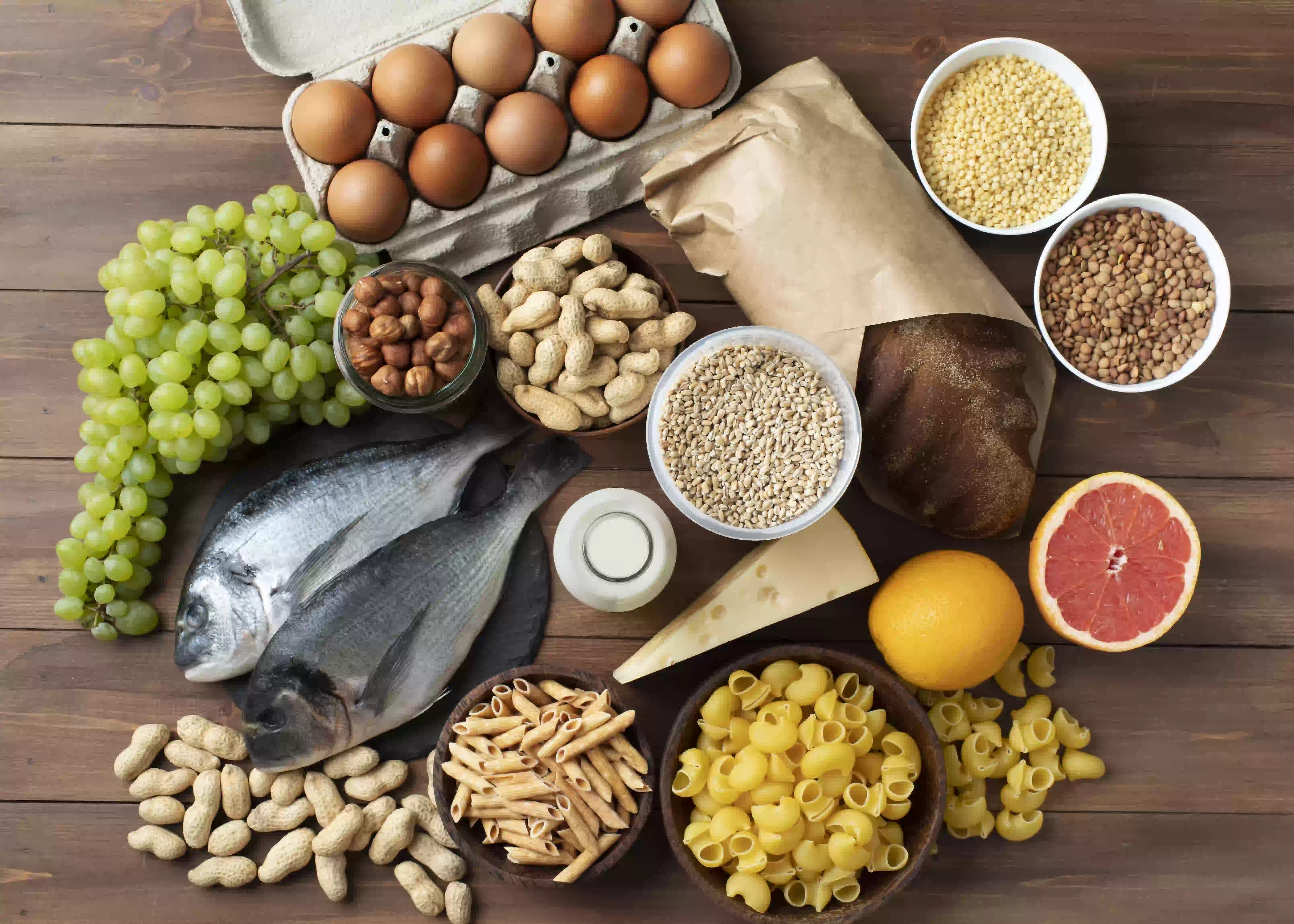Our bodies cannot digest fiber because it comes from the cell walls of plants. Fiber is a type of complex carbohydrate found in plant cell walls that cannot be broken down by the human digestive system. Despite being indigestible, fiber plays a vital role in promoting digestion, maintaining a balanced diet, and even reducing the risk of certain diseases when consumed in sufficient amounts.
The easiest way to meet your daily fiber needs? Add more vegetables and fruits to your meals.
According to the World Health Organization (WHO), adults should consume about 25–30 grams of fiber per day. The National Academy of Sciences recommends between 19–38 grams daily, depending on age and gender.
Recognize the signs of fiber deficiency before it’s too late!
Signs Your Body Is Low in Fiber
Not getting enough fiber doesn’t immediately cause dangerous diseases. However, if left untreated over time, this condition can increase the risk of developing serious health problems. Before that happens, watch out for these common symptoms of fiber deficiency:
- Constipation
Constipation is one of the most common signs of low fiber intake. It occurs when bowel movements happen less than three times a week. Fiber, especially soluble fiber, plays an essential role in helping the intestines contract so digestion runs smoothly. When fiber intake is insufficient, intestinal movement slows down, leading to constipation. - Bloating
A low-fiber diet slows down peristaltic movement—or the muscular contractions of the digestive tract. As a result, food moves more slowly, and gas becomes trapped inside the intestines, making the stomach feel full, tight, or bloated. - Frequent Hunger
Fiber, especially soluble fiber, helps suppress the production of ghrelin—the hunger hormone. When you consume enough fiber, you stay full longer. Conversely, a low-fiber diet makes hunger return quickly, even after eating. - Weight Gain
Low-fiber foods are digested quickly, causing you to feel hungry sooner and eat more frequently. Over time, this habit increases calorie intake and leads to weight gain. - Increased Bad Cholesterol (LDL)
Fiber helps lower bad cholesterol (LDL) by binding to cholesterol in the digestive tract, preventing it from being absorbed into the bloodstream. Without enough fiber, cholesterol from food is absorbed more easily, raising LDL levels. - Higher Risk of Heart Disease
High LDL cholesterol can trigger heart problems. Fiber, along with nutrients like B vitamins, zinc, and iron, helps lower this risk. A long-term fiber deficiency significantly increases your chances of cardiovascular disease. - Blood Sugar Spikes
Fiber is digested slowly, which helps maintain stable blood sugar levels. A low-fiber diet—especially if it includes lots of simple carbohydrates like white rice or noodles—can cause blood sugar to spike quickly after meals, raising the risk of diabetes.
Many people don’t realize that symptoms like constipation, bloating, or constant hunger can signal a lack of fiber. If ignored, this can lead to more serious health problems. That’s why it’s important to understand the risks and take action early.
What Happens When You Don’t Get Enough Fiber?
Over the long term, insufficient fiber intake can make you more vulnerable to a range of health issues—from minor digestive discomfort to chronic diseases. Here are some conditions to watch out for:
- Constipation
Constipation involves infrequent bowel movements (fewer than three times per week), hard stools, and straining. Fiber—especially soluble fiber—helps draw water into the intestines and form a soft, gel-like mass, making stools easier to pass. Without it, stools become dry and hard, leading to more frequent constipation.
Simply put: less fiber = harder stools = more constipation. - Type 2 Diabetes
Fiber, particularly soluble fiber, stabilizes blood sugar because it slows carbohydrate absorption. A low-fiber diet—especially one high in simple carbs—can cause rapid blood sugar spikes, increasing the risk of insulin resistance and type 2 diabetes. - Diverticulitis
Diverticulitis occurs when small pouches (diverticula) form in the intestinal wall and become inflamed or infected. Low fiber often leads to constipation; frequent straining increases intestinal pressure, creating these pouches. If they become irritated or infected, it can cause abdominal pain, fever, and serious complications. - Heart Disease
High-fiber diets are linked to lower cholesterol and better blood sugar control—both crucial for heart health. Fiber binds some cholesterol and helps remove it through waste. Research also shows that higher fiber intake lowers the risk of heart disease and cardiovascular mortality. Without enough fiber, you lose this natural protection. - Obesity
Fiber helps you feel full longer by slowing stomach emptying and stabilizing blood sugar levels. A low-fiber diet leads to more frequent hunger, overeating, and ultimately weight gain and obesity. Adding fiber-rich foods—vegetables, fruits, legumes, whole grains—can help control appetite and manage weight.
Clearly, fiber deficiency is no small matter. Its impact goes beyond digestive discomfort to serious conditions like diabetes, heart disease, and obesity. The good news? You can prevent it with a simple step: ensure you get enough fiber every day.
So, how can you meet your daily fiber needs? Let’s find out.
How to Meet Your Daily Fiber Needs
To stay healthy, you need both soluble fiber and insoluble fiber every day. Each plays a unique role in digestion and overall health:
Soluble Fiber
Absorbs water during digestion, softens stool, and helps lower blood cholesterol. Found in:
- Green vegetables
- Fruits (apples, oranges, grapes)
- Legumes
- Oats
Insoluble Fiber
Doesn’t dissolve in water; adds bulk to stool and prevents constipation. Found in:
- Green peas
- Soy products
- Brown rice
- Whole-grain products
Daily Fiber Recommendations
According to the American Heart Association:
- Adults: 25–30 grams per day (from natural foods, not supplements)
- Children:
- Ages 2–5: 15 g/day
- Ages 5–11: 20 g/day
- Ages 11–16: 25 g/day
- Ages 17+: 30 g/day
Tips to Increase Fiber Intake
- Eat more fruits and vegetables
Aim for five servings of fruit daily. Enjoy them as snacks, add to cereals or oatmeal, or use as salad toppings.
- High-fiber fruits: bananas, pears, apples (with skin), strawberries, oranges
- Fiber-rich vegetables: green beans, broccoli, turnip greens, potatoes, corn, cauliflower, carrots - Snack on soy-based products
Soy isn’t just rich in fiber—it’s also packed with protein, vitamin C, folate, calcium, iron, magnesium, phosphorus, and B vitamins. It can help control blood sugar, lower cholesterol, and keep you feeling full longer. - Add whole grains to your meals
Incorporate oats, whole-grain bread, and brown rice into your daily diet.
- Replace white rice with brown rice gradually
- Use whole-grain flour for baking
- Add grains to salads, soups, or yogurt - Consider fiber supplements (if needed)
Whole foods are best, but if you can’t meet your needs through diet, your doctor may recommend fiber supplements—preferably those containing both soluble and insoluble fiber, plus prebiotics and probiotics for optimal benefits.
Meeting your daily fiber needs—around 25 grams, according to the 2019 Dietary Guidelines—can help prevent constipation, boost immunity, stabilize blood sugar, and lower the risk of chronic diseases. High-fiber diets are also associated with longer life expectancy and reduced cancer risk.
Source:
- Amanda, E. N., Anggraini, D., Hasni, D., & Jelmila, S. N. (2022). Gambaran tingkat pengetahuan tentang pentingnya konsumsi serat untuk mencegah konstipasi pada masyarakat Kelurahan Rengas Condong Kecamatan Muara Bulian/Kabupaten Batanghari Provinsi Jambi. Jurnal Kedokteran dan Kesehatan: Publikasi Ilmiah Fakultas Kedokteran Universitas Sriwijaya, 9(2). https://doi.org/10.32539/jkk.v9i2.17010
- https://www.nestlehealthscience.co.id/ (5 Gangguan Kesehatan yang Bisa Timbul Akibat Kekurangan Serat Pada Tubuh) diakses pada 17 Juli 2025
- klikdokter.com (Catat, Ini Tanda Tubuh Anda Kurang Serat) diakses pada 17 Juli 2025
- klikdokter.com (Konsumsi Serat yang Diperlukan Tubuh dalam Sehari) diakses pada 17 Juli 2025
- hallosehat.com (Ragam Cara Mudah Mencukupi Kebutuhan Serat Harian) iakses pada 17 Juli 2025

